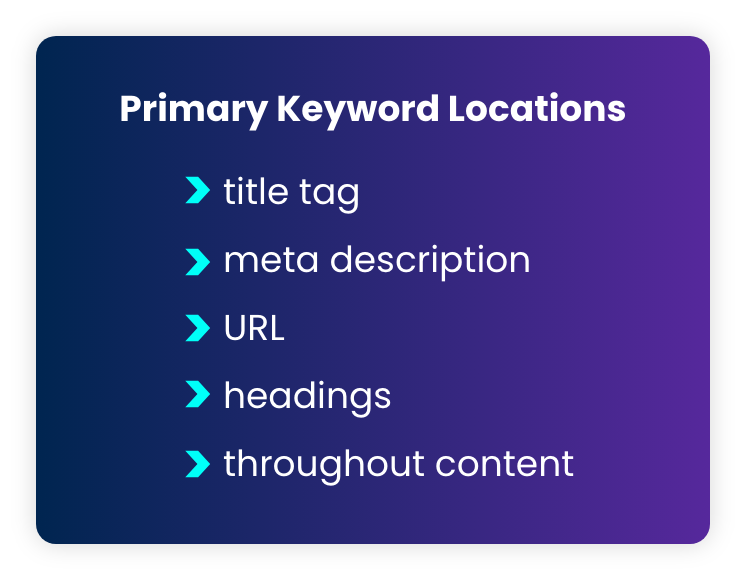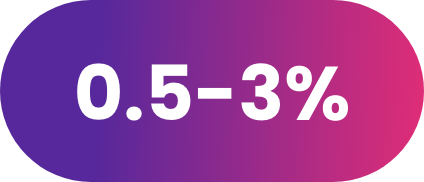
How Many Keywords Should I Use for SEO?
Search Engine Optimization (SEO) is a dynamic field that requires careful consideration of various factors and precise execution to successfully increase the visibility of a website. One of the most debated aspects of search engine optimization we often hear is, “how many keywords should I use for SEO?”
While we’d love to give you an ideal number and send you on your way, the answer isn’t that simple. Let’s explore the core principals of SEO, as well as the nuances of keyword usage, to help you strike the perfect balance and give your content its best chance at ranking.
Understanding Keywords in SEO

For the Keywords are the terms and phrases that users type into search engines when looking for information.
Incorporating relevant keywords into your website content helps search engines understand the topic of your pages, thus improving your chances of ranking higher in search results. Keywords vary greatly in their search volume, and their difficulty to rank higher in search results. Websites and tools like SEMrush assign a percentage to represent how difficult it will be to rank with a certain keyword. The higher the percentage, the more high-quality content you will need to have a chance to rank.
The Evolution of Keyword Strategy
In the early days of SEO, keyword stuffing—cramming as many keywords as possible into your content—was a common practice. However, search engines have evolved, and their algorithms are now much more sophisticated. Modern SEO focuses on delivering high-quality, relevant content that provides value to users. In fact, practices like keyword stuffing are now looked at unfavorably by search engines and can have significant negative effects on the search engine visibility of your entire website.
Ideal Number of SEO Keywords: Quality Over Quantity
The key to effective keyword usage is finding the perfect balance. Here are some guidelines to help you determine the ideal number of keywords for your SEO strategy:

Focus on Primary Keywords
Each page of your website and piece of content you publish should target a primary keyword. This is the main term you want the page or content to rank for. The primary keyword should appear in key locations such as the title tag, meta description, URL, headings, and naturally throughout the content.
Incorporate Secondary Keywords
In addition to your primary keyword, utilize secondary keywords. These are related terms and variations that support the main topic. They help provide context and can capture additional search queries. For example: if your primary keyword is “best gaming computers”, your secondary keywords could be something like, “best gaming PCs” or “best computers for gaming.”

A typical page or blog should target 2-3 secondary keywords without appearing spammy or over-optimized.
Secondary keywords should be dispersed throughout your content nearly as much – if not equal to – your primary keywords. You should also try to include one in your meta description and introduction section, if possible.
Use Long-Tail Keywords
Long-tail keywords are longer, more specific phrases that often have lower search volume but higher conversion rates. They are less competitive and can drive highly targeted traffic to your site. Incorporating a mix of long-tail keywords is an excellent tactic to enhance your SEO strategy. Using the previous example, a long-tail keyword related to the best gaming computers would be, “what is the best gaming computer in 2024?” or “what is the best PC for gaming?”

Aim for 3-5 long-tail keywords per page, scattering them naturally throughout your content.

Long tail keywords can be so valuable that they can be used as primary keywords. If you want to see an example, check the title of this blog.
Maintain Natural Keyword Density
Keyword density refers to the percentage of times a keyword appears in your content compared to the total word count.

While there is no hard and fast rule, a good practice is to keep keyword density between 0.5-3%.
The way our writers approach this is to ensure we include each keyword at least twice every 1000 words. This ensures that your content remains natural and readable while avoiding penalties from search engines due to keyword overuse.
SEO Best Practices for Keyword Usage
Keyword density refers to the percentage of times a keyword appears in your content compared to the total word count.
Conduct Thorough Keyword Research
Use tools like Google Keyword Planner, Ahrefs, and Semrush to identify the best keywords for your niche.

Look for terms with a balance of high search volume and low competition. Understanding user intent behind keywords is crucial. The best way to understand user intent is to put yourself in the user’s shoes. Visit a search engine like Google and think about what you would search for if you were your ideal customer. Consider their pain points, curiosities, and core values when conducting keyword research to find the most effective ways to reach your audience.
Create High-Quality Content
Content should always be created for the user first and optimized for search engines second. High-quality content that answers users’ questions and provides valuable information will naturally incorporate relevant keywords. While search engine algorithms are constantly changing, they continue to consistently reward content that is informative, well-written, and engaging.
Optimize Meta Tags
Meta tags are pieces of information you use to tell search engines and those viewing your site more about your page and the information it contains. Ensure your primary keyword appears in the title tag, meta description, image descriptions, and URL. Meta tags are crucial for controlling how your content is presented to users on search results and for search engine crawlers to understand the content of your page. Write compelling meta descriptions that include keywords to improve click-through rates.
Use Keywords in Headings and Subheadings
Incorporate primary and secondary keywords in your headings (H1, H2, H3, etc.). This not only helps with SEO but also improves readability and structure of your content. Headings should guide the reader through the content logically.
Monitoring and Adjusting Your SEO Strategy
SEO is an ongoing process, not a one-time task. Regularly monitor your website’s performance using tools like Google Analytics and Search Console. Pay attention to which keywords are driving traffic and which are not performing as expected. Adjust your keyword strategy based on data and trends. If a piece of content is performing worse than expected, don’t be afraid to adjust and re-optimize the content to target different keywords or read more naturally.
Avoiding Common SEO Pitfalls
SEO is an ongoing process, not a one-time task. Regularly monitor your website’s performance using tools like Google Analytics and Search Console. Pay attention to which keywords are driving traffic and which are not performing as expected. Adjust your keyword strategy based on data and trends. If a piece of content is performing worse than expected, don’t be afraid to adjust and re-optimize the content to target different keywords or read more naturally.

Keyword Stuffing
Overloading your content with keywords can result in search engine penalties. It also creates a poor user experience and can hurt the trust your audience has in your company. Focus on writing naturally and incorporate keywords where they fit.

Ignoring User Intent
Understanding the intent behind search queries is crucial. Users might be looking for information, wanting to make a purchase, or seeking a specific website. Align your content with the intent behind the keywords to provide the most relevant, high value information.

Neglecting Mobile Optimization
With the rise of mobile searches, ensuring your content is optimized for mobile devices is paramount. This includes having a responsive design, fast loading times, and mobile-friendly content. Keywords should be naturally integrated into mobile-optimized content.
Striking The Perfect Balance
The number of keywords you should use for SEO is less about hitting a specific count and more about strategic placement and quality. Focus on primary and secondary keywords, incorporate long-tail keywords, and ensure a natural keyword density. Create high-quality content that serves the user’s intent and continuously monitor and adjust your strategy. By following these guidelines, you can enhance your SEO efforts and improve your website’s visibility in search engine results.
Remember, the ultimate goal of SEO is to create a seamless and valuable experience for users while making your content easily discoverable by search engines. Prioritize quality over quantity before you ask yourself “how many keywords should I use for SEO” and you’ll be well on your way to achieving optimal SEO results.
If you need more expert SEO guidance or help creating content that ranks on search engines and delivers valuable traffic to your website, don’t hesitate to contact the experts at Vonazon. Our SEO team can help increase your online visibility, elevate your brand, and establish your company as an authority in its industry.
Recent Posts
Categories
Categories
- ABM
- Account Management
- Analytics
- Artificial Intelligence
- Content Marketing
- Creative
- CRM
- Design
- eCommerce
- Email Marketing
- HubSpot
- HubSpot Content Hub
- HubSpot CRM
- HubSpot Marketing Hub
- HubSpot Partner
- HubSpot Sales Hub
- Inbound Marketing
- Integrations and Migrations
- Lead Generation
- Lead Scoring
- Marketing
- Marketing Automation
- Marketing Strategy
- Native Advertising
- Omnichannel Marketing
- Organization
- PPC
- Programmatic Advertising
- Sales and Marketing Alignment
- SEO
- Social Media
- Staffing
- Trade Shows
- Videos
- Web Development
- Webinars
HOW CAN We
HELP YOU?
Lorem ipsum dolor sit amet, consectetur adipiscing elit.



